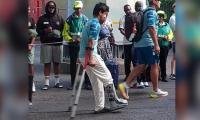ZURICH: In 1977, Heinz Wagner, the chief executive at Crypto who knew the true role of the CIA and BND, abruptly fired a wayward engineer after the NSA complained that diplomatic traffic coming out of Syria had suddenly became unreadable. The engineer, Peter Frutiger, had long suspected Crypto was collaborating with German intelligence. He had made multiple trips to Damascus to address complaints about their Crypto products and apparently, without authority from headquarters, had fixed their vulnerabilities.
Frutiger “had figured out the Minerva secret and it was not safe with him,” according to the CIA history. Even so, the agency was livid with Wagner for firing Frutiger rather than finding a way to keep him quiet on the company payroll. Frutiger declined to comment for this story.
US officials were even more alarmed when Wagner hired a gifted electrical engineer in 1978 named Mengia Caflisch. She had spent several years in the United States working as a radio-astronomy researcher for the University of Maryland before returning to her native Switzerland and applying for a job at Crypto. Wagner jumped at the chance to hire her. But NSA officials immediately raised concerns that she was “too bright to remain unwitting.”
The warning proved prescient as Caflisch soon began probing the vulnerabilities of the company’s products. She and Spoerndli, a colleague in the research department, ran various tests and “plaintext attacks” on devices including a teletype model, the HC-570, that was built using Motorola technology, Spoerndli said in an interview.
“We looked at the internal operations, and the dependencies with each step,” Spoerndli said, and became convinced they could crack the code by comparing only 100 characters of enciphered text to an underlying, unencrypted message. It was an astonishingly low level of security, Spoerndli said in an interview last month, but far from unusual. “The algorithms,” he said, “always looked fishy.”
In the ensuing years, Caflisch continued to pose problems. At one point, she designed an algorithm so strong that NSA officials worried it would be unreadable. The design made its way into 50 HC-740 machines rolling off the factory floor before company executives discovered the development and stopped it.
“I just had an idea that something might be strange,” Caflisch said in an interview last month, about the origin of her suspicions. But it became clear that her probing wasn’t appreciated, she said. “Not all questions appeared to be welcome.”
The company restored the rigged algorithm to the rest of the production run and sold the 50 secure models to banks to keep them out of the hands of foreign governments. Because these and other developments were so hard to defend, Wagner at one point told a select group of members of the research and development unit that Crypto “was not entirely free to do what it wanted.”
The acknowledgment seemed to subdue the engineers, who interpreted it as confirmation that the company’s technology faced constraints imposed by the German government. But the CIA and BND became increasingly convinced that their routine, disembodied interference was unsustainable.
Crypto had become an Oz-like operation with employees probing to see what was behind the curtain. As the 1970s came to a close, the secret partners decided to find a wizard figure who could help devise more advanced — and less detectable — weaknesses in the algorithms, someone with enough cryptological clout to tame the research department.
The two agencies turned to other spy services for potential candidates before settling on an individual put forward by Sweden’s intelligence service. Because of Hagelin’s ties to the country, Sweden had been kept apprised of the operation since its outset.
Kjell-Ove Widman, a mathematics professor in Stockholm, had made a name for himself in European academic circles with his research on cryptology. Widman was also a military reservist who had worked closely with Swedish intelligence officials.
To the CIA, Widman had an even more important attribute: an affinity for the United States that he had formed while spending a year in Washington state as an exchange student.
His host family had such trouble pronouncing his Swedish name that they called him “Henry,” a moniker he later used with his CIA handlers.
Officials involved in Widman’s recruitment described it as almost effortless. After being groomed by Swedish intelligence officials, he was brought to Munich in 1979 for what purported to be a round of interviews with executives from Crypto and Siemens.
The fiction was maintained as Widman faced questions from a half-dozen men seated around a table in a hotel conference room. As the group broke for lunch, two men asked Widman to stay behind for a private conversation.
“Do you know what ZfCh is?” asked Jelto Burmeister, a BND case officer, using the acronym for the German cipher service. When Widman replied that he did, Burmeister said, “Now, do you understand who really owns Crypto AG?”
At that point, Widman was introduced to Richard Schroeder, a CIA officer stationed in Munich to manage the agency’s involvement in Crypto. Widman would later claim to agency historians that his “world fell apart completely” in that moment.
If so, he did not hesitate to enlist in the operation.
Without even leaving the room, Widman sealed his recruitment with a handshake. As the three men joined the rest of the group at lunch, a “thumbs up” signal transformed the gathering into a celebration.
Crypto installed Widman as a “scientific advisor” reporting directly to Wagner. He became the spies’ hidden inside agent, departing Zug every six weeks for clandestine meetings with representatives of the NSA and ZfCh. Schroeder, the CIA officer, would attend but tune out their technical babble.
They would agree on modifications and work up new encryption schemes. Then Widman would deliver the blueprints to Crypto engineers. The CIA history calls him the “irreplaceable man,” and the “most important recruitment in the history of the Minerva program.”
His stature cowed subordinates, investing him “with a technical prominence that no one in CAG could challenge.” It also helped deflect the inquiries of foreign governments. As Widman settled in, the secret partners adopted a set of principles for rigged algorithms, according to the BND history. They had to be “undetectable by usual statistical tests” and, if discovered, be “easily masked as implementation or human errors.”
In other words, when cornered, Crypto executives would blame sloppy employees or clueless users.
In 1982, when Argentina became convinced that its Crypto equipment had betrayed secret messages and helped British forces in the Falklands War, Widman was dispatched to Buenos Aires. Widman told them the NSA had probably cracked an outdated speech-scrambling device that Argentina was using, but that the main product they bought from Crypto, the CAG 500, remained “unbreakable.”
“The bluff worked,” the CIA history says. “The Argentines swallowed hard, but kept buying CAG equipment.”
To be continued
All necessary arrangements for the re-polling have been completed, ECP spokesperson
Regarding ban on student unions, Senator Masroor Ahsan calls for clear guidelines to govern their operation
Chairman Rai Hassan Nawaz presids over meeting at Railway Headquarters in Lahore
Seminar will highlight remarkable efforts of probationary officers in addressing critical societal challenges
He highlights nation’s mental health challenges and stressed need for collective action to address them
In December 2024, PAC directed Sindh HEC to investigate matter and submit report within two weeks







